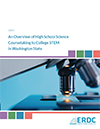This study uses five years of student administrative records to explore 9th graders’ science course-taking patterns through high school years, from 2012-13 to 2015-2016,; and examines the association between those patterns and college STEM success. Major findings are addressed below:
- About 31 percent of the 9th grader cohort went beyond the state’s high school graduation requirements by earning more than 2 course credits in core science, including biology, physics or chemistry.
- Students earning more than 2 core-science credits in high school are more likely to earn STEM course credits in the first year of college.
- More high school credits earned in physics or chemistry than in biology are predictive of earning college STEM credits.
- College STEM outcomes differ across student demographics and family income status.
- A higher proportion of females than males earn college STEM credits, especially among those going through high school coursework concentrating on biology.
- Holding high school science coursework constant, racial/ethnic differences exist in the regard to proportion of earning college STEM credit. In general, Asians hold the highest proportion of earning college STEM credit, followed by Whites.
- Disparity in college STEM outcomes by family income status is found among students with the same science coursework patterns. The gap is larger among students who earned science credits with concentration in either physics or chemistry.


